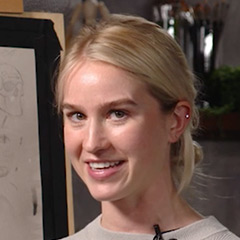
Rendering Hair
Savannah Tate CuffAs artist Savannah Tate Cuff continues to demonstrate a portrait drawing with a live model, it’s time to render, or model the hair. Savannah has established the flat shadow shapes of the hair with the darker values that describe the model’s brown hair, using HB and B pencils. Savannah uses hair as an opportunity to think about design and create asymmetry and visual interest. Don’t forget to think about the skull underneath, with enough mass to the back of the skull. If the hair is close to the head, you’ll want to indicate the high and low points of the skull.
Savannah thinks visually for the hair, rather than the conceptual way of thinking that guides her rendering of facial features. Because the model’s hair has changed slightly from day to day, Savannah adjusts the shapes from her block-in, keeping the hair soft. She uses a stump to quickly darken or adjust value in a section, and simplifies the hair so it can be a place for the viewer’s eye to rest, even leaving a few areas slightly unfinished. Forms such as braids should be modeled specifically, however, with attention to the light source. The hairline is soft where the hair meets the forehead.
In Savannah’s drawing, the hair frames the face, eliminating the need for a background. Final details include a few hair strands that add to the motion and movement of the portrait. Savannah cautions against our natural tendency to make elements similar — be sure you have asymmetry and variety in the shapes you indicate. On the outer hair edge, add areas with lost edges along with a few sharper moments for a more interesting drawing. Finally, Savannah reminds us that we can design the hair to guide the viewer to the eyes.
